

Shamans and scientists. By Jeremy Narby, anthropologist with Swiss NGO Nouvelle Planète and author of The Cosmic Serpent, DNA and the Origins of Knowledge.
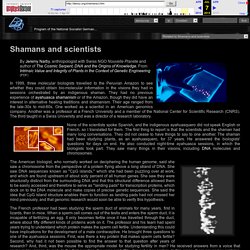
From Intrinsic Value and Integrity of Plants in the Context of Genetic Engineering (PDF) In 1999, three molecular biologists travelled to the Peruvian Amazon to see whether they could obtain bio-molecular information in the visions they had in sessions orchestrated by an indigenous shaman. They had no previous experience of ayahuasca shamanism or of the Amazon, though they did have an interest in alternative healing traditions and shamanism. Their age ranged from the late-30s to mid-60s. One worked as a scientist in an American genomics company. None of the scientists spoke Spanish, and the indigenous ayahuasquero did not speak English or French, so I translated for them.
Horizons 2013: Dennis McKenna, Ph.D. "Ayahuasca Yesterday Today and Tomorrow Perspectives on the Past & Future of Ayahuasca” Ayahuasca Vault : Scientific Investigation of Ayahuasca, McKenna, Callaway, Grob 1998. Dennis J McKenna, PhD -- Heffter Research Institute J C Callaway, PhD -- Department of Pharmaceutical Chemistry, University of Kuopio, Finland Charles S Grob MD --Heffter Research Institute, Department of Psychiatry, Harbor/UCLA Medical Center,
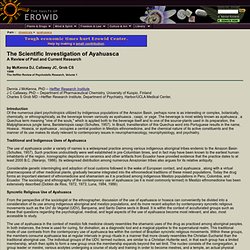
Ayahuasca: An Ethnopharmacologic History. Dennis McKenna, Reality SandwichWaking Times **The following is excerpted from The Ayahuasca Experience, edited by Ralph Metzner, Ph.D., recently released in a new edition by Park Street Press.** Join Dennis McKenna for the live, interactive video course, “What Plants Can Teach You: Consciousness and Intelligence in Nature.”
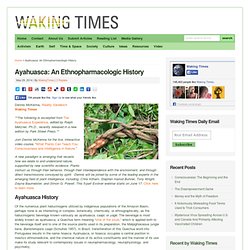
A new paradigm is emerging that recasts how we relate to and understand nature, supported by new scientific evidence. Ayahuasca and The Healing of a Broken Heart. Aya Workshop www.thehiddendoorway.com I’ve participated in, or worked as a facilitator on 207 Ayahuasca journeys.
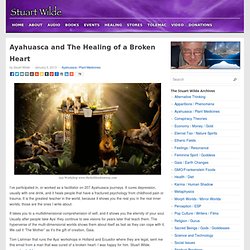
It cures depression, usually with one drink, and it heals people that have a fractured psychology from childhood pain or trauma. It is the greatest teacher in the world, because it shows you the real you in the real inner worlds, those are the ones I write about. It takes you to a multidimensional comprehension of self, and it shows you the eternity of your soul. Usually after people take Aya’ they continue to see visions for years later that teach them.
Tom Lishman that runs the Aya’ workshops in Holland and Ecuador where they are legal, sent me this email from a man that was cured of a broken heart. From Tom Lishman The Hidden Doorway Ayahuasca works on many levels. As luck would have it, I was attending the first of two workshops in Ecuador at the time and I immediately asked him to drop everything and get on the next plane to attend the second one. Banisteriopsis Caapi (Peru) - Powdered Yellow. The Dark Side of Ayahuasca. Kyle Nolan spent the summer of 2011 talking up a documentary called 'Stepping Into the Fire,' about the mind-expanding potential of ayahuasca.

The film tells the story of a hard-driving derivatives trader and ex-Marine named Roberto Velez, who, in his words, turned his back on the "greed, power, and vice" of Wall Street after taking ayahuasca with a Peruvian shaman. The film is a slick promotion for the hallucinogenic tea that's widely embraced as a spirit cure, and for the Shimbre Shamanic Center, the ayahuasca lodge Velez built for his guru, a potbellied medicine man called Master Mancoluto. The film's message is that we Westerners have lost our way and that the ayahuasca brew (which is illegal in the United States because it contains the psychedelic compound DMT) can set us straight.
Devotees talk about ayahuasca's cathartic and life-changing power, but there is a dark side to the tourism boom as well. Few experts blame the concoction itself. Ethnobotany - Introduction - Archaeobotany-Wiki. From Archaeobotany-Wiki What is ethnobotany?
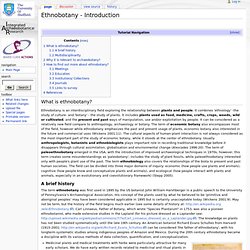
Ethnobotany is an interdisciplinary field exploring the relationship between plants and people. It combines 'ethnology' -the study of culture- and 'botany' - the study of plants. It includes plants used as food, medicine, crafts, crops, weeds, wild or cultivated, and the present and past ways of manipulation, use and/or exploitation by people. It can be considered as a relatively new field compare to anthropology, archaeology or botany. A brief history The term ethnobotany was first used in 1895 by the US botanist John William Harshberger in a public speech to the University of Pennsylvania’s Archaeological Association.
Medicinal plants and medical treatments with herbs were particularly attractive for many early scholars. Multidisciplinarity Why it is relevant to archaeobotany? Woman and wheat, Aksaray 1994, picture taken by F. Why studying ethnobotany is relevant? How to find out more about ethnobotany? Meetings Education Institutions/ Collections.